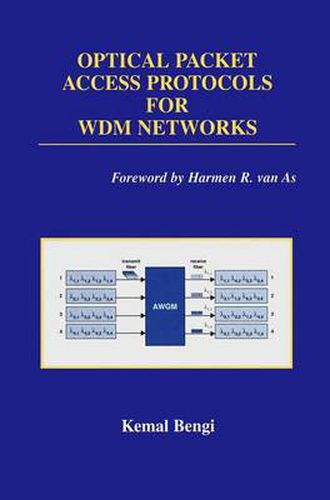Readings Newsletter
Become a Readings Member to make your shopping experience even easier.
Sign in or sign up for free!
You’re not far away from qualifying for FREE standard shipping within Australia
You’ve qualified for FREE standard shipping within Australia
The cart is loading…






This title is printed to order. This book may have been self-published. If so, we cannot guarantee the quality of the content. In the main most books will have gone through the editing process however some may not. We therefore suggest that you be aware of this before ordering this book. If in doubt check either the author or publisher’s details as we are unable to accept any returns unless they are faulty. Please contact us if you have any questions.
The fast growing traffic demand in telecommunication networks, by use of the Internet and an increasing number of broadband services for multimedia com munications, requires new high performance networking technologies. As such, optical WDM networks are playing a pivotal role. Wavelength Division Mul tiplexing (WDM) with many hundreds of wavelength channels per fiber is ex tensively being exploited in wide area networks. With respect to the ongoing trend towards a completely packet-switched mode of operation for all services, WDM networks must be prepared accordingly. This work concentrates on optical packet-switched networking in local and metro area networks for realizing high-performance applications like virtual re ality, medical imaging, and supercomputing. It is well known that in those networks using a star, bus, or ring shared medium, an access protocol is nec essary to guarantee controlled and fair access for all attached nodes. Similar access protocols are to be developed and analyzed for WDM local and metro area networks. Already, many media access protocols for these networks have been described in the literature. However, some aspects of Quality-of-Service (QoS) for different service classes are still an open issue and subject to inten sive research activities. In the introduction, the author, Dr. Kemal Bengi, gives a short classification of media access protocols and network architectures for WDM local and metro area networks. The need for service classes is also em phasized.
$9.00 standard shipping within Australia
FREE standard shipping within Australia for orders over $100.00
Express & International shipping calculated at checkout
This title is printed to order. This book may have been self-published. If so, we cannot guarantee the quality of the content. In the main most books will have gone through the editing process however some may not. We therefore suggest that you be aware of this before ordering this book. If in doubt check either the author or publisher’s details as we are unable to accept any returns unless they are faulty. Please contact us if you have any questions.
The fast growing traffic demand in telecommunication networks, by use of the Internet and an increasing number of broadband services for multimedia com munications, requires new high performance networking technologies. As such, optical WDM networks are playing a pivotal role. Wavelength Division Mul tiplexing (WDM) with many hundreds of wavelength channels per fiber is ex tensively being exploited in wide area networks. With respect to the ongoing trend towards a completely packet-switched mode of operation for all services, WDM networks must be prepared accordingly. This work concentrates on optical packet-switched networking in local and metro area networks for realizing high-performance applications like virtual re ality, medical imaging, and supercomputing. It is well known that in those networks using a star, bus, or ring shared medium, an access protocol is nec essary to guarantee controlled and fair access for all attached nodes. Similar access protocols are to be developed and analyzed for WDM local and metro area networks. Already, many media access protocols for these networks have been described in the literature. However, some aspects of Quality-of-Service (QoS) for different service classes are still an open issue and subject to inten sive research activities. In the introduction, the author, Dr. Kemal Bengi, gives a short classification of media access protocols and network architectures for WDM local and metro area networks. The need for service classes is also em phasized.